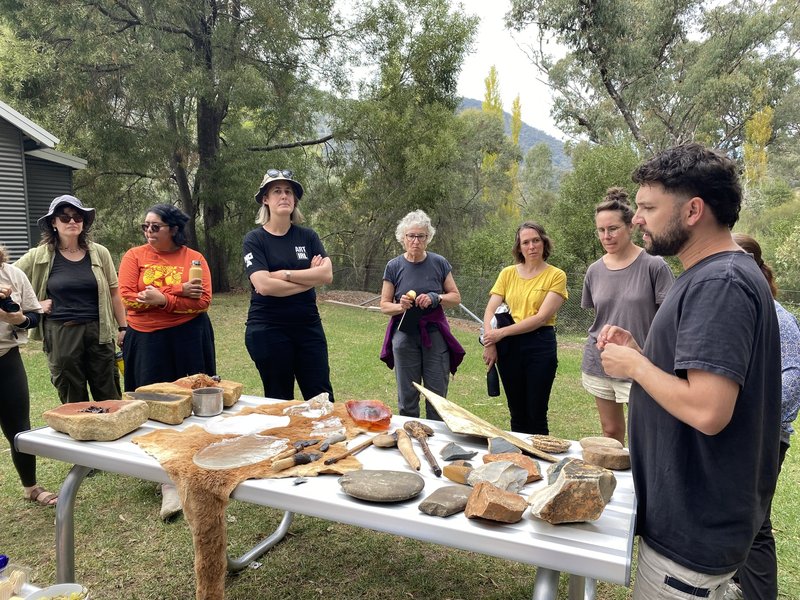ANU’s proposed restructure threatens studio-based art education
The proposed changes raise concerns about staff reductions and the future of hands-on, discipline-based learning.
The proposed changes raise concerns about staff reductions and the future of hands-on, discipline-based learning.

Studio-based art education in Australia has faced relentless pressure for decades, and the proposed restructure of the Australian National University is another move to chip away at its foundations. The plan would collapse ANU’s internationally recognised School of Art and Design (SoAD), Centre for Heritage and Museum Studies (SoHMS) and School of Music (SoM), into a broad School of Creative and Cultural Practice under the College of Arts and Social Sciences (CASS).
While the restructure does not propose formal course closures, it includes significant staff cuts and a shift from discipline-specific structures to broad, interdisciplinary “labs.” These changes risk dismantling the core teaching and leadership models that have sustained practice-based and community-engaged programs for decades. The process has also raised concerns about transparency and timing, with some staff notified of redundancies only weeks before semester commencement, compounding stress and limiting meaningful consultation.
Studio-based education is about experimentation, critical thinking, and interpretation. It fosters invention, care, and rigour. ANU’s current model is nationally respected and deeply embedded in community life. Artists such as eX de Medici, Daniel Boyd, Danie Mellor, and Dean Cross, alongside a new generation including Jacquie Meng, Jackson Taylor, and Sophie Dumaresq, have emerged from this program, a testament to its strength, reputation, and transformative approach to studio-based learning.
The Environment Studio is one example. Established through deep engagement with Uncle Ossie Cruse and the Yuin community in 2011, the program laid the groundwork for sister initiatives with Wolgalu, Ngunnawal, and Ngambri community representatives, demonstrating how sustained relationships create further opportunities. It is now nationally recognised for field-based, interdisciplinary teaching that extends well beyond visual arts, engaging students across law, anthropology, engineering, and more. While the proposal praises its First Nations engagement, it also plans to disestablish the very role responsible for maintaining these relationships, without clarity on how this work will be supported into the future.
Similarly, the Foundation Studies program, which provides core skill-building in areas such as observational drawing, is proposed for disestablishment, with its remaining content to be absorbed into broader visual arts teaching. These roles are not just about delivering technical content, they are foundational to student confidence, interdisciplinary collaboration, and the kind of humanist and critical thinking that underpins all good art education.
It is also concerning that many of the roles proposed for redundancy appear to be held by women and are those with strong community-facing or interdisciplinary profiles. These patterns raise broader equity concerns and reflect a narrowing of the university’s vision of what constitutes valuable, future-focused academic work.
In 2019, ANU committed to an $80 million vision for a new art school. That vision was never realised. Instead, we have seen successive rounds of program reductions, staff cuts, and now a restructure that moves further away from discipline-led education toward a more diffuse model.
An Open Letter on Equity in Higher Education highlights the damaging impact of the Job-ready Graduates (JRG) policy, which continues to influence institutional decision-making. By doubling the cost of arts and humanities degrees and tying funding to narrow job outcome metrics, JRG has put further pressure on universities already grappling with funding cuts and performance-based priorities.
Across the country, visual arts programs are being hollowed out. The loss of studio-based programs worsens workforce shortages, reduces opportunities for artists to teach, and limits the ability of future generations to access critical, experimental learning.
NAVA continues to call on the university sector and the Commonwealth Government to restore equitable, affordable access to arts degrees, and to protect the integrity of visual arts education before further damage is done.
ANU CASS Consultation is open for feedback until 12pm AEST Thursday 7 August 2025. Please email your feedback to org.change@anu.edu.au.
ANU School of Art and Design academic Aidan Hartshorn discusses stone tool making as part of the recent Sharing Stories Arts Exchange program on Walgalu Country, in the Tumut region of NSW. Photo by Julia Boyd.
ID: A group of people stand in a semi-circle outdoors, listening to a man speaking beside a white table covered with natural materials and tools. On the table are various stones, ochres, animal hides and traditional implements. The setting is a grassy area surrounded by trees, with hills visible in the background.